At a glance
Expert’s Rating
Pros
- Windows 11
- A slight improvement in processing power
Cons
- Pretty much the same as the Surface Go 2
- Keyboard and pen must be purchased separately
Our Verdict
The Microsoft Surface Go 3 is the Surface Go 2 of 2021, and that’s about all there is to say.
Best Prices Today

Microsoft touts its 10.5-inch Surface Go 3 tablet as its most mobile Surface. While that’s definitely true, what else does the new Surface Go 3 have to offer? A small processor bump, Windows 11, and, well, that’s about it.
The Surface Go 3 is essentially the same device as the Surface Go 2. We don’t consider Windows 11 to be necessarily worth the upgrade, which robs the Surface Go 3 of its appeal. As for the processor upgrade — yes, there’s now a 10th-gen Core i3 option, but it doesn’t really move the needle performance-wise.
Surface Go 3: basic features and available configurations
Microsoft’s Surface Go 3 is available in three configurations, ranging from $399.99 on up to $629.99, which is the price of our review unit. We wouldn’t recommend the $399.99 base model (with a Pentium Gold 6500Y, 4GB of RAM, and 64GB of storage) because the 4GB of memory isn’t sufficient for running multiple apps. The other configurations, including a midrange version (Pentium Gold 6500Y/8GB RAM/128GB SSD: $549.99) and the premium offering (Intel Core i3/8GB RAM/128GB SSD: $629.99), round out the offerings.
The Surface Go 3 is unique because there aren’t many small, inexpensive Windows tablets vying for your wallet. Otherwise, the Go 3 is priced similarly to Microsoft’s budget clamshell laptop, the Surface Laptop Go, which also has a $549.99 discounted version that includes a Core i5-1035G1 with 8GB of memory and a 128GB SSD. The Laptop Go’s screen is a definite step down, however.
Unlike the prior Surface Go 2, the current version of the Surface Go 3 consumer version doesn’t ship with cellular options. It’s a somewhat odd omission, though our Go 2 review indicated that its cellular reception was spotty. Microsoft reserved the LTE option for what it calls the Surface Go 3 for Business, which ships in both a $499.99 (Core i3/4GB RAM/64GB SSD) and a $679.99 (Core i3/8GB RAM/128GB SSD) configuration, each with an LTE SIM tray that the consumer version lacks. The Business configuration also allows you to chose either Windows 10 Pro or Windows 11 Pro, an odd choice given the optional 4GB RAM configuration.
Unlike the Surface Pro 8, the Surface Go’s Type Cover has not been redesigned to accommodate the Surface Slim Pen 2. And yes, you still have to buy the keyboard separately. The Type Cover’s prices range from $59.99 to $129.99, depending on color and available discounts. For inking, there’s the older $99.99 Surface Pen. Unfortunately, there’s no pen loop to secure the pen with the Go 3, though the side of the tablet is magnetized to help keep the pen in place when not in use.
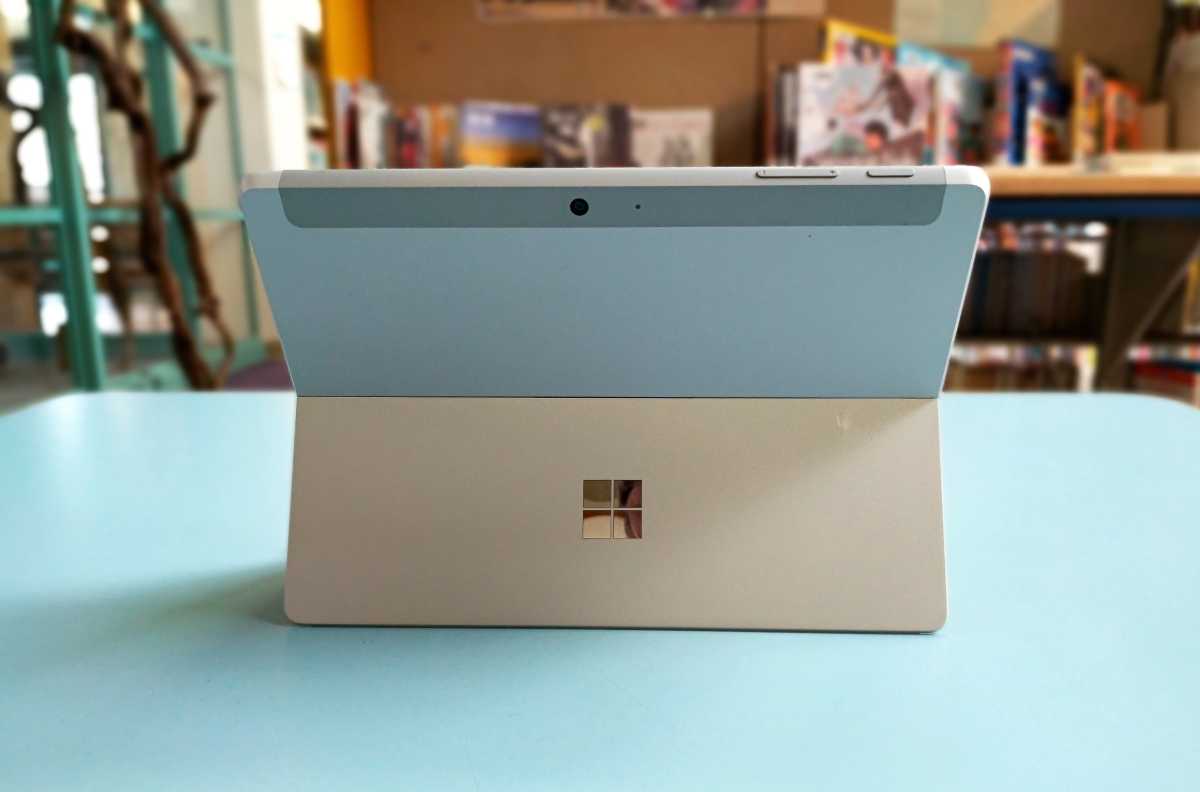
Mark Hachman / IDG
- Processor: Intel Pentium Gold 6500Y, Core i3-10100Y (Core i3 as tested)
- Display: 10.5-inch PixelSense (1920×1280, 220 PPI)
- Memory: 4GB/8GB LPDDR3 (8GB as tested)
- Storage: 64 GB (eMMC) /128GB (SSD) (128GB as tested)
- Graphics: UHD Graphics 615
- Ports: USB-C (5Gbps), Surface Connect, microSDXC, Surface Connect, Surface Type Cover
- Security: Windows Hello depth camera
- Camera: User-facing: 5.0MPixel (1080p video); Rear-facing: 8.0MP (1080p video)
- Battery: 26.8Wh (design), 26.0Wh (full)
- Wireless: Wi-Fi 6 (802.11ax), Bluetooth 5.0
- Operating system: Windows 11 Home in S Mode
- Dimensions: 9.65. x 6.9 x 0.33in. (8.3mm)
- Weight: 1.2 pounds (without keyboard)
- Color: Platinum
- Prices: $399.99 on up, $629.99 as tested
- Optional accessories: Surface Go Type Cover ($84.99-$129.99 MSRP), Surface Pen ($99.99)
The Surface Go 3 looks physically identical to its predecessor, with slightly thinner bezels than the original to accommodate the 10.5-inch, 1920×1280 PixelSense display. Microsoft typically uses the chunky bezels as landing pads for your fingers and thumbs. It seems they’ve dimmed the display a bit, however, as we recorded a maximum brightness of 374 nits as opposed to the Go 2’s 483 nits. Like its predecessors, the Go 3 does away with the fan as well as the vents, letting the magnesium chassis passively radiate any heat that the tablet generates.
Out of the box, the most significant change to the Surface Go 3 involves the transition to Windows 11, specifically the addition of Windows 11 Home in S Mode. This means two different things. First, setup involves stepping through the soothing sequence of introductions as described in our Windows 11 review. Secondly, Windows 11 Home in S Mode handcuffs you by restricting apps to the Microsoft Store, as Windows 10 S (Windows 10 Home in S Mode) did.
This restriction helps secure the PC by ensuring that you’ll only download apps that Microsoft has nominally vetted. But if you want to download a third-party browser like Google Chrome, for example, you can’t. We also have yet to see tangible upgrades in the performance and battery life that Microsoft originally promised with S Mode. All this means is that I quickly switched out of Windows 11 in S Mode for the “real” Windows 11 Home, which took a minute or two.

Mark Hachman / IDG
Microsoft’s mobile experience
Using the Surface Go 3 feels more like a mobile experience than a typical tablet or laptop (even during a pandemic). Windows 11’s updated tablet experience simply adds a small software-based keyboard to the UI when the keyboard is undocked, which allows you to freely wander about the house. The Go 3’s narrow display bezels are about a fingers width apart and the compact dimensions make it uniquely suited to using it as a traditional tablet.
You can use the Go 3 while at a desk or you can easily throw it into a backpack. Like previous Surface Go devices, however, I found it much easier to use at a desk than on my lap. There’s one part on the Type Cover’s dual-hinge that holds onto the tablet fast, preventing the keyboard from flipping backwards and out of your lap. But the secondary hinge detaches easily, flopping the keyboard down into a flat (and uncomfortable) orientation. To be fair, the Go’s size does allow for working under cramped conditions such as on a train’s pull-down table.
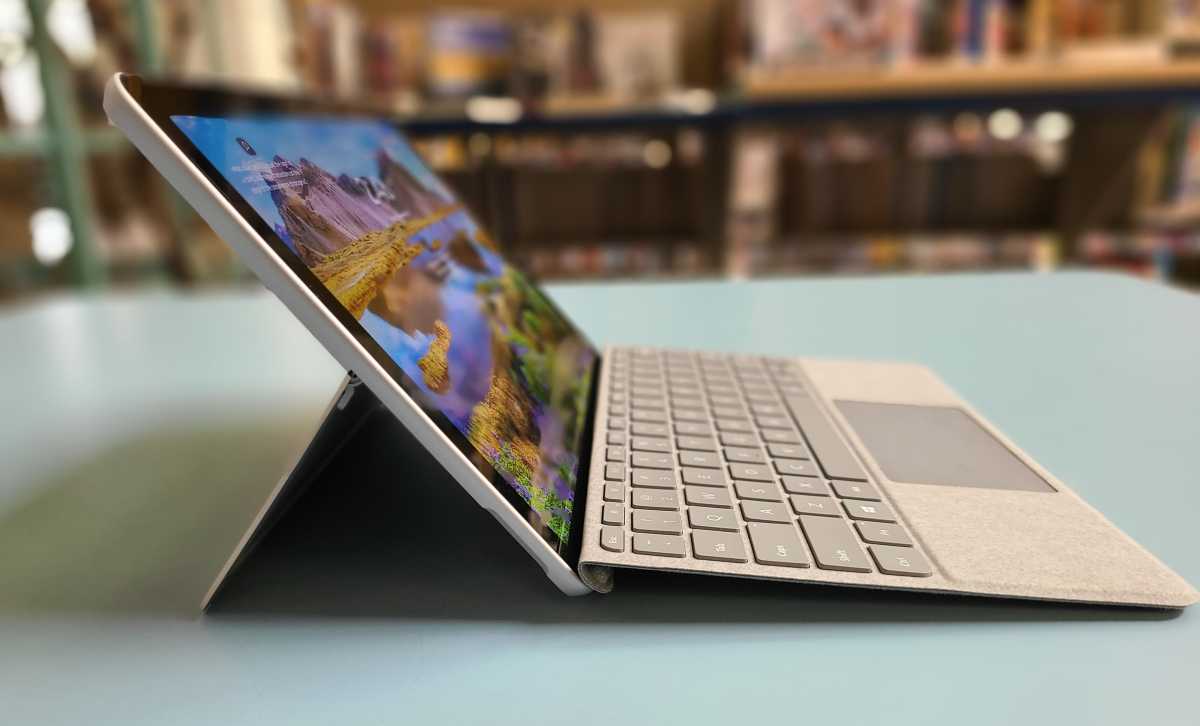
Mark Hachman / IDG
Consuming as well as creating digital content, however, has its wrinkles. For one, the Surface Go 3 hasn’t yet migrated to using Thunderbolt, which means that you’ll still need to use either the Surface Dock (or the newer, pricier Surface Dock 2) to connect to an external display. The Surface Go can also connect via a USB-C dongle to an external display, to a single 1080p display or a 4K monitor running at 30 Hz.
Keyboard, audio and webcam: a decent value
The Surface Go 3’s keyboard remains unchanged from the Surface Go 2, so my opinion hasn’t changed either. A small tablet means a small keyboard, one that’s tolerable (though a bit uncomfortable) to type upon for long periods of time. The keyboard’s key travel remains at a shallow 1mm, with less key travel than some of the other excellent keyboards within the Surface lineup. A child’s fingers may be small enough to type on the keys, but adults won’t really enjoy it.
As for the audio, the tablet features a pair of front-facing 2W stereo speakers enhanced by Dolby Audio. It offers a satisfactory (even good) audio experience. While Microsoft has dialed down the blaring speaker volume from the Surface Go, it offers a solid mix of high-end and midrange audio. I never felt the need to plug in a pair of earbuds into the headphone jack, which is one of the higher compliments that you can give a laptop or tablet.
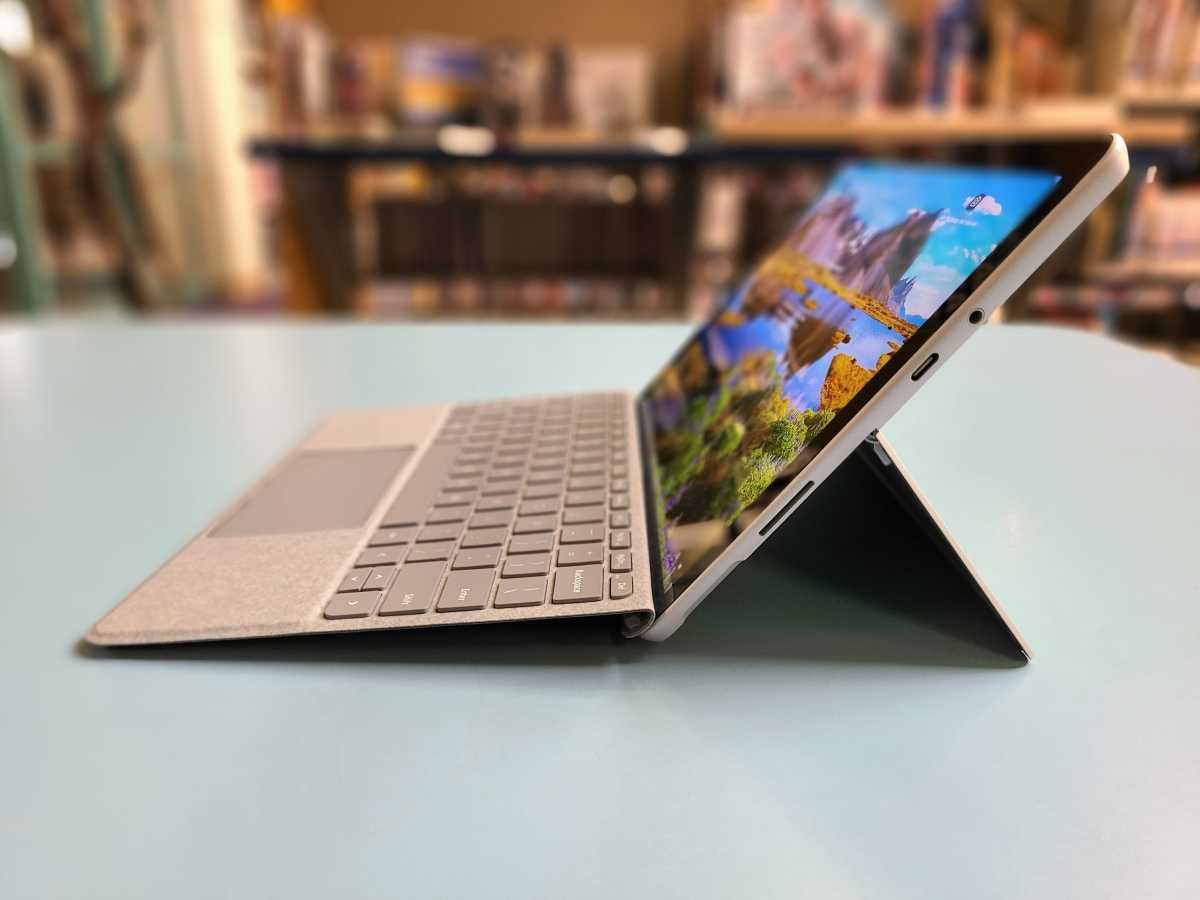
Mark Hachman / IDG
The front-facing 5.0Mpixel webcam continues to provide decent color saturation and lighting, though without the new lighting and color sensors added to the Surface Pro 8. With the easy migration of photos between smartphones and PCs, the rear-facing camera seems less necessary with each passing generation. But the Go’s small size makes snapping a photo less awkward than with larger tablets and the 8Mpixel resolution is plenty sufficient for capturing documents and well-lit scenes.
The Go also features dual far-field mics. However, the importance of such mics has diminished as Microsoft has eased away from an environment where users are expected to call across the room to Windows’ built-in Cortana assistant.
Still, there’s certainly something to be said for a video-friendly tablet. My youngest son uses a Windows laptop for remote schooling and a tablet for video chatting with his friends, and the Surface Go 3 combines the two.
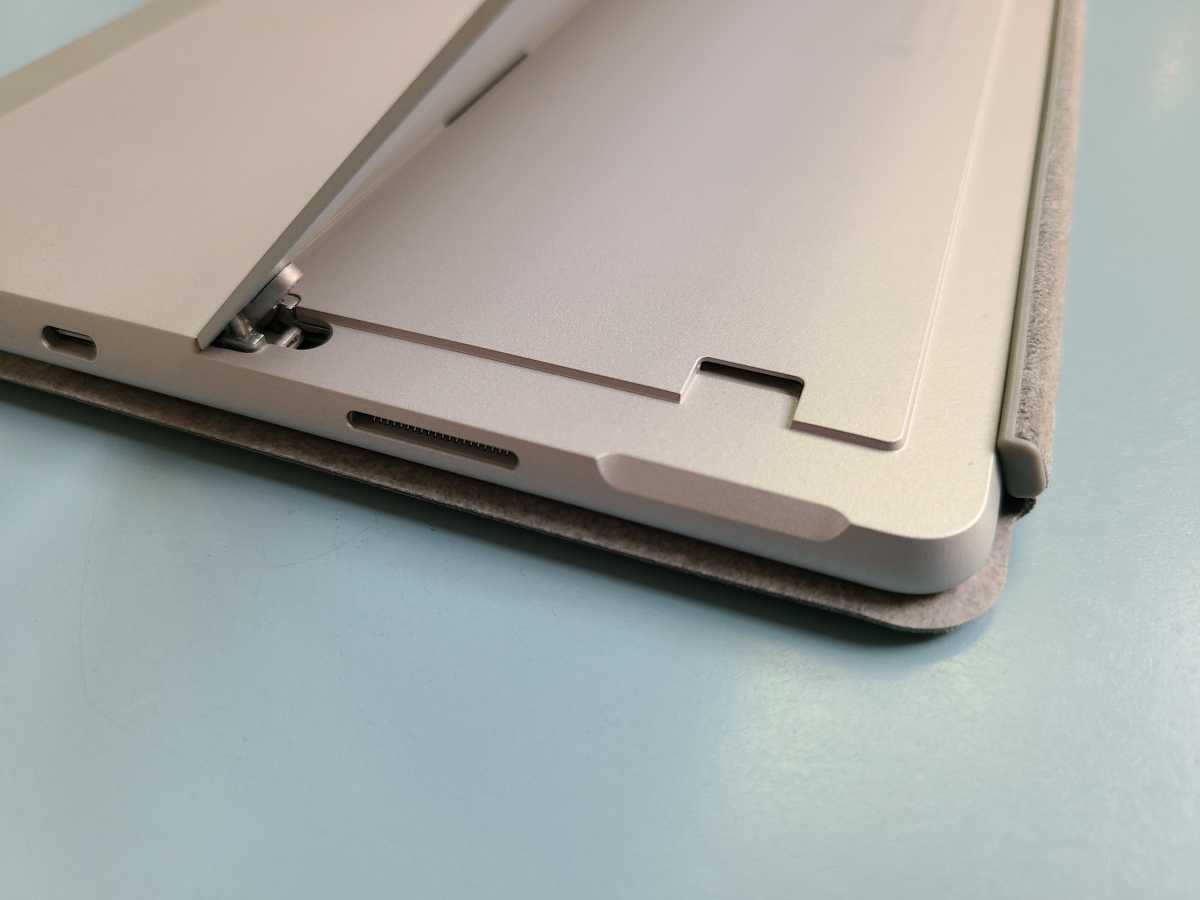
Mark Hachman / IDG
Inking isn’t particularly impressive. I tried inking with the Surface Slim Pen and there’s noticeable line offset and significant jitter (a wavy motion) when moving the pen at a diagonal. The Go 3 is fine for casually drawing, but nothing more.
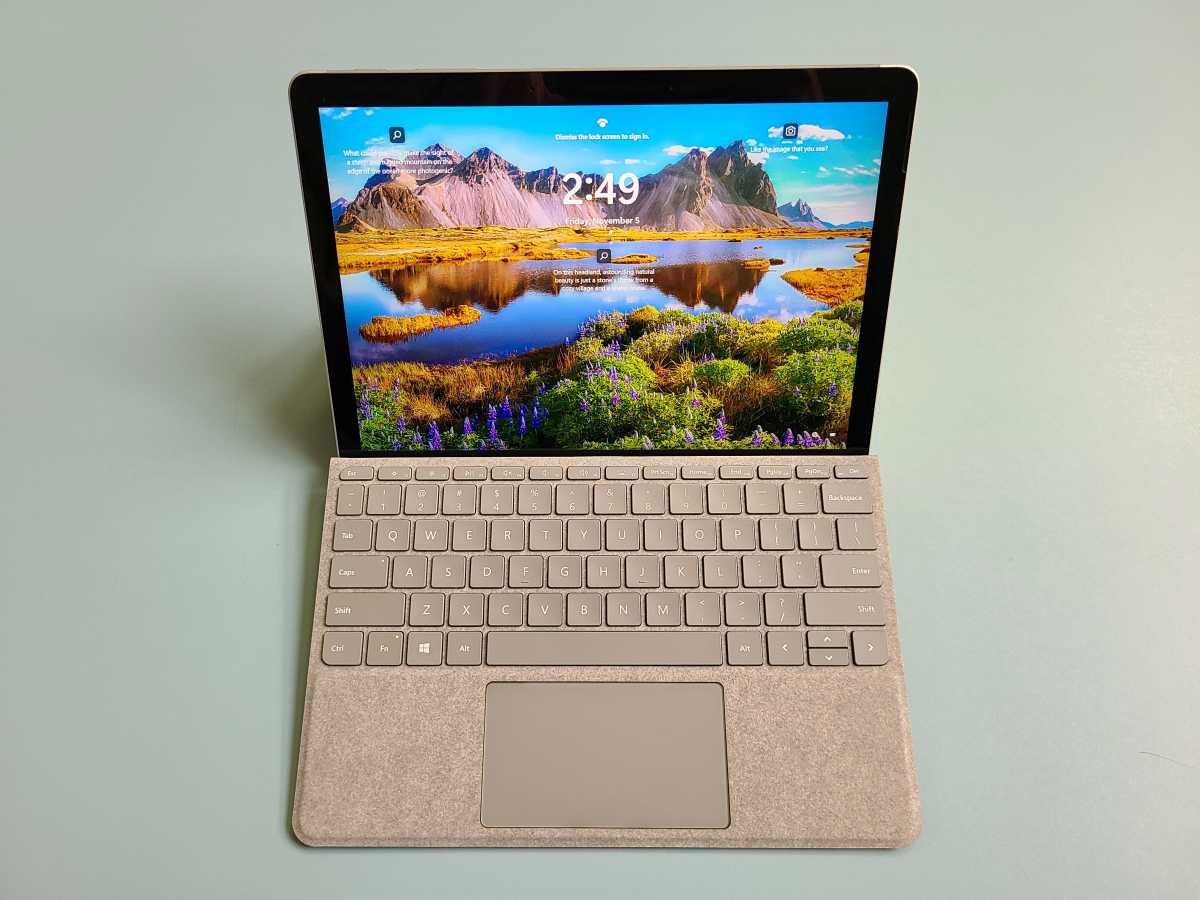
Mark Hachman / IDG
Performance: Not much improvement
We tested the Surface Go 3 using our standard benchmarks and real-world tests. The Go 3 streamed a “4K/60” YouTube video without dropping a frame. YouTube scales video to the size of the display it detects, however, so the tablet was essentially downloading a 720p video and upscaling it. When we connected to a 4K display, it appeared to drop about 40 percent of its frames before YouTube dialed back the resolution to 1080p, which streamed flawlessly.
We didn’t try any games with the Go 3, but it performed fairly typical tasks like web browsing, Zoom/Teams, and streaming video. Be mindful that anything under 8GB of RAM may limit the number of tabs you can have open at any one time and the number of apps you can run simultaneously.
Finally, it’s worth noting that Microsoft ships many of its recent Surface tablets and notebooks with performance turned down to minimal levels to maximize battery life. We adjusted the Windows 11 power mode to “best performance” to see if the tablet ran any faster. It did, but only by about 6 percent at most — adjusting the power/performance levels certainly won’t transform a Surface Go 3 into a speed demon. It will, however, help elevate performance above the Surface Go 2 in some cases.
Otherwise, we run four performance tests: PCMark 10, Cinebench R15, Handbrake, and 3DMark. Most of these are geared at higher-performing mainstream laptops like the Dell Latitude 7320 Detachable, the Lenovo ThinkPad X12 Detachable Gen 1, the Microsoft Surface Pro 7+, and the new Surface Pro 8. While understanding how the Surface Go 3 compares to those tablets is useful, it’s perhaps more illustrative to see how far the tablet has progressed from the second-gen Surface Go 2 instead. We’ve highlighted the Go 2 in orange.
UL’s PCMark10 benchmark puts the tablet through a variety of tasks like web browsing, light gaming, CAD work, video editing, and more. It’s a solid measure of how well the Surface Go 3 will fare in day-to-day work. Here, the Go 3’s performance dips by about 2 percent. With the power mode’s performance setting turned up to best performance, the Go 3 records a score of 2,804.
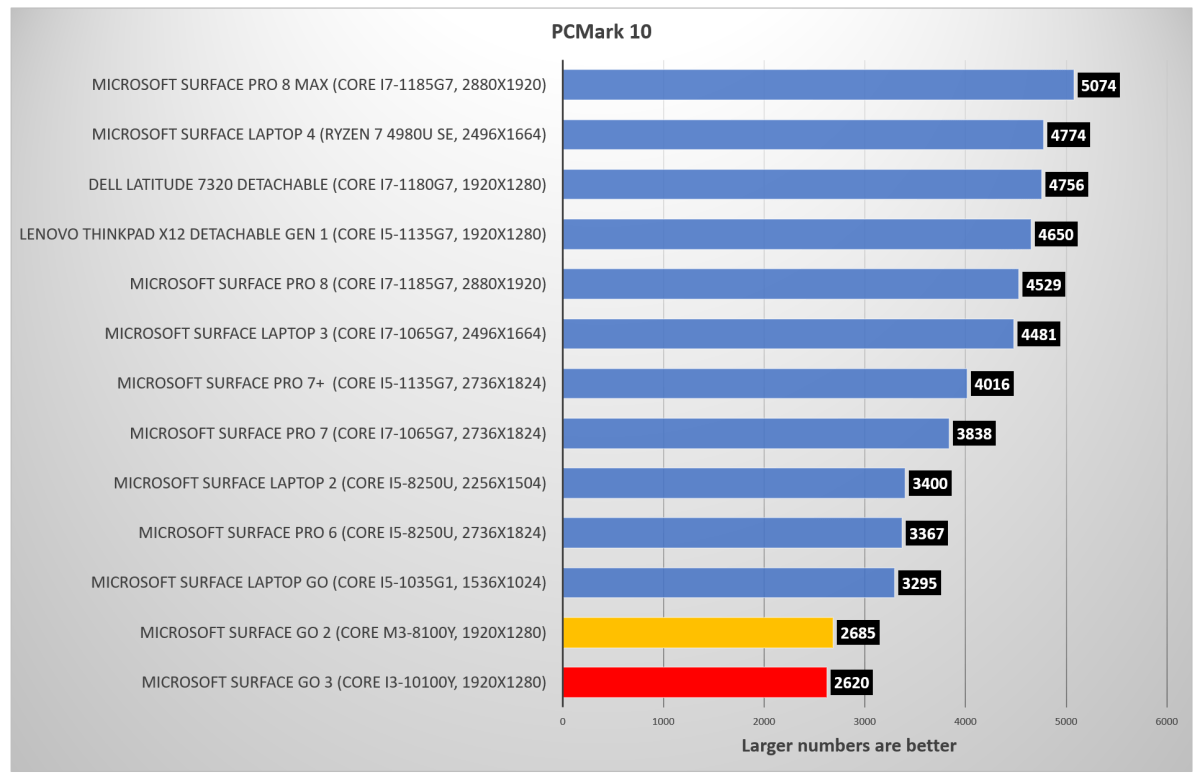
Mark Hachman / IDG
The older Cinebench R15 test measures how well the Surface Go 3 performs with all of its cores and threads in active use. Unfortunately, any application that can take full advantage of all the laptop’s cores and threads will see more benefit from a six-core or eight-core processor rather than the two-core four-thread Core i3-10100Y. Remember, we’re testing the top-of-the-line version of the Surface Go 3.
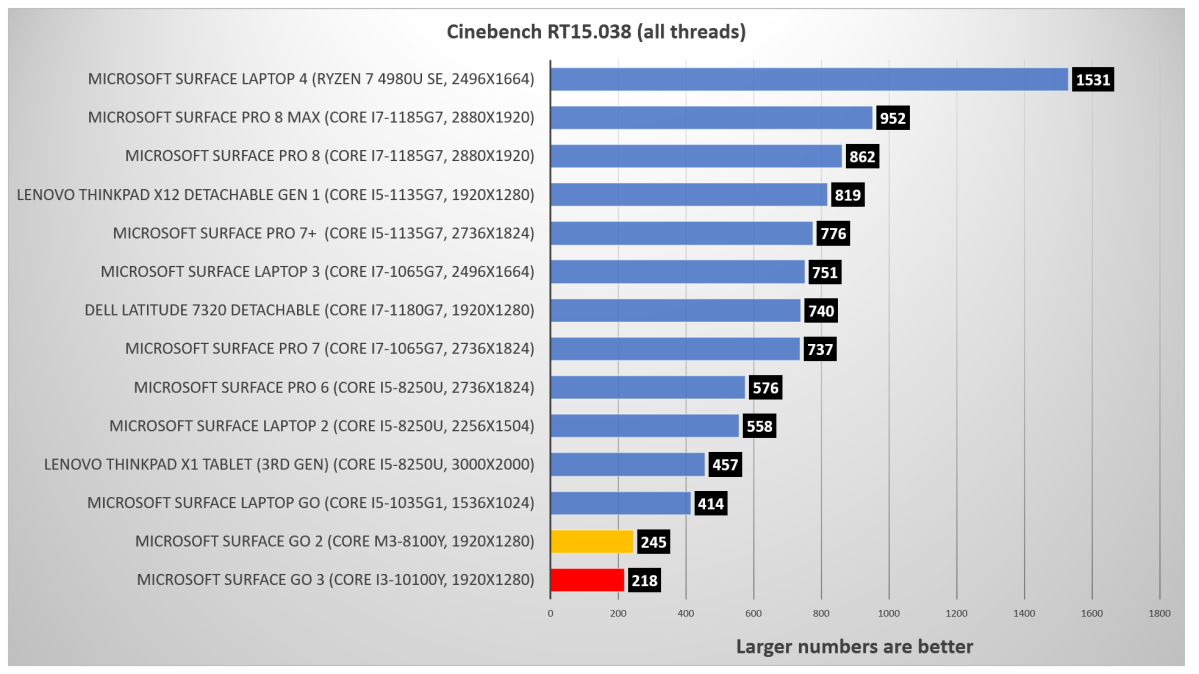
Mark Hachman / IDG
What’s interesting is that we’re seeing the older Surface Go 2 report higher scores than the Surface Go 3, both in multithreaded applications as well as single-threaded applications (126 to 119). If you do buy the Go 3, consider adjusting the power mode upwards. In “Best performance” mode, it reported a multithreaded score of 260, and a single-threaded score of 132.
We used Handbrake, which is an open-source transcoding tool, as a prolonged stress test of the processor. Using this tool, we converted video from its native format down to a lower-resolution format for playing back on a tablet. The test typically lasts over an hour. Can the fanless Surface Go 3 keep up with more powerful tablets? Our results say no, not really. In performance mode, the time required to perform the task dipped 3 percent to 7,847 seconds.
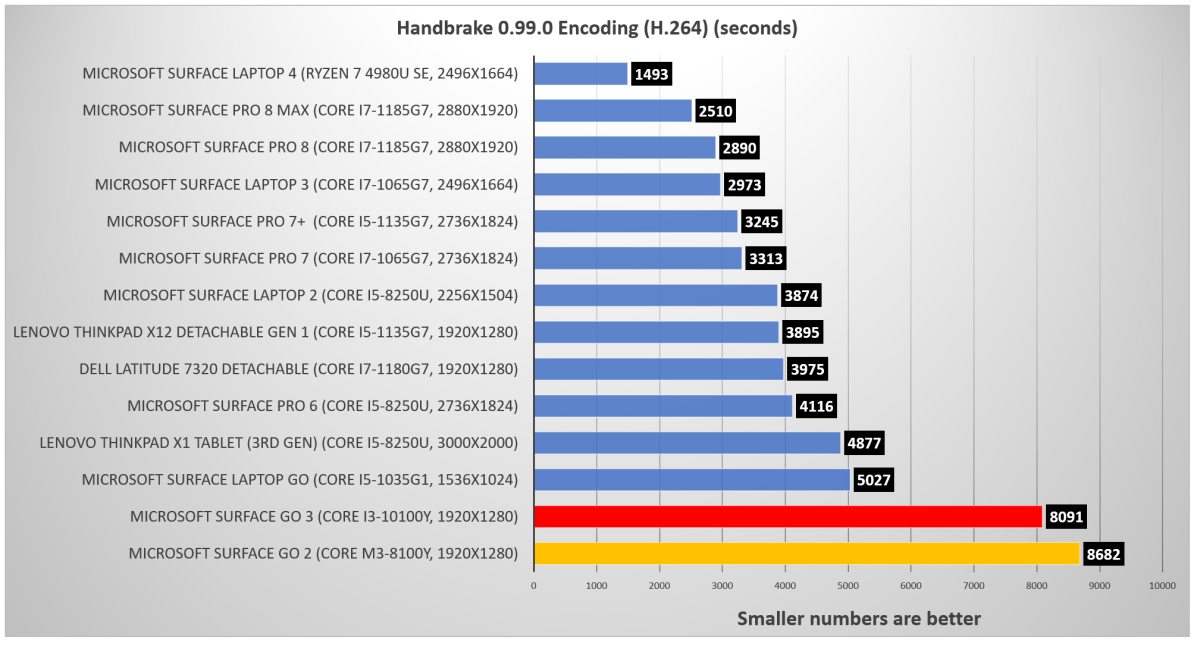
Mark Hachman / IDG
Our final test uses the 3DMark “Time Spy” benchmark. It’s futile to test the Surface Go 3 as a gaming tablet, but we’ve provided the numbers for reference. It’s important to note that the Go 3 and the Go 2 use the same GPU. Only the CPU has changed between the two products. At maximum performance, the 3DMark score increased 6 percent to 385.

Mark Hachman / IDG
Since the Go 3 uses approximately the same amount of battery capacity as its predecessors, we expected similar battery life. We weren’t disappointed. It still provides slightly less than eight hours of battery life, meaning that you’ll need to tote along the charger to keep it running through a full day’s work.
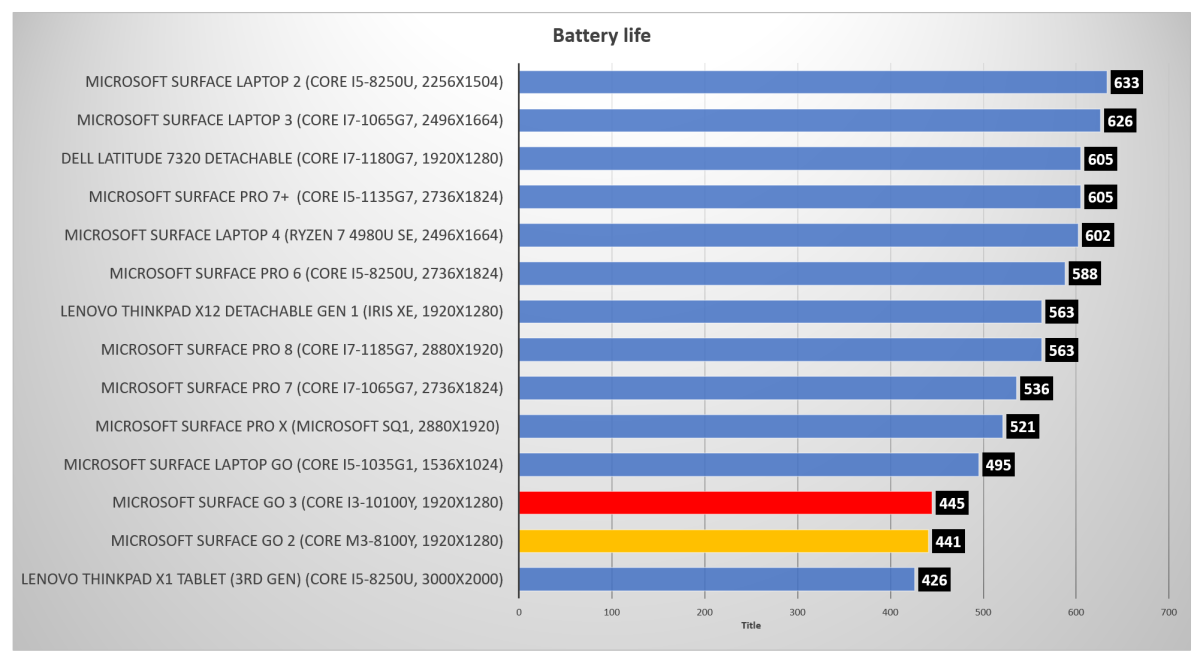
Mark Hachman / IDG
Conclusion: You have two tablets to choose from
At some point we may ask our colleagues at Macworld to help compare the iPad, the Surface Go 3, and an Android tablet. For now, we’re comfortable in advising you to select whatever OS suits your fancy. You probably shouldn’t be choosing a Surface Go 3 — or an iPad — for performance, but for the convenience and portability factor. There’s a reason you’ll often see Microsoft’s Surface Go 3 accompanied by photos of kids and business travelers — this is very much a niche product, no pun intended.
There’s an unexpected secondary option, too. We wouldn’t necessarily recommend the Surface Go 2 over the newest Surface Go 3, but we can see why you might consider it. With comparable performance plus an available LTE consumer option (plus Windows 10, if you prefer the older operating system) an older, discounted Surface Go 2 might offer more value. Officially, the MSRP for both the Go 2 and Go 3 are about the same.
Put simply, there’s little reason to buy the Surface Go 3 over the Surface Go 2, though buying a new PC means that it will still be covered under the Go 3’s one-year limited hardware warranty. Otherwise, we’d recommend you use our pricing tool just above and explore your Go 2 options if Microsoft’s small portable tablet is your first choice. The Surface Go 3 simply doesn’t differentiate itself enough from last year’s model to justify much excitement.
Note: When you purchase something after clicking links in our articles, we may earn a small commission. Read our affiliate link policy for more details.
"Review" - Google News
November 18, 2021 at 06:30PM
https://ift.tt/3wZXjU4
Surface Go 3 review: A lateral upgrade for Microsoft's uniquely affordable tablet - PCWorld
"Review" - Google News
https://ift.tt/2YqLwiz
https://ift.tt/3c9nRHD
Bagikan Berita Ini














0 Response to "Surface Go 3 review: A lateral upgrade for Microsoft's uniquely affordable tablet - PCWorld"
Post a Comment